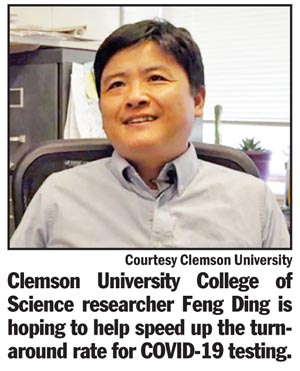Clemson researcher working to create much faster COVID-19 test
By Frances Parrish
Clemson University
news@thepccourier.com
CLEMSON — Clemson University scientist Feng Ding is working to develop a quick detection test for COVID-19 with funding from a one-year National Science Foundation RAPID grant.
 Ding said that current COVID-19 tests require samples
Ding said that current COVID-19 tests require samples to be sent to a lab with a potential waiting period of days before patients get back their results. Ding is hoping this $190,065 grant and his work with Pengyu Chen, a Clemson alumnus and now an assistant professor at Auburn University in Alabama, will change the turnaround rate for COVID-19 testing.
to be sent to a lab with a potential waiting period of days before patients get back their results. Ding is hoping this $190,065 grant and his work with Pengyu Chen, a Clemson alumnus and now an assistant professor at Auburn University in Alabama, will change the turnaround rate for COVID-19 testing.
“The idea with this test is to detect traces of the virus protein with highly sensitive sensors enabled by nanotechnology,” said Ding, an associate professor in the College of Science’s department of physics and astronomy. “And hopefully we could do that at the site of care by quickly analyzing the patient sample in as few as 15 minutes.”
Ding and Chen plan to do this by developing a new nanomaterial-based sensor with the capability to detect virus proteins in real time. This project builds on prior research of riboswitches commonly used by single-cell organisms for gene regulation. When sensing metabolites or small molecules, a riboswitch can change its three-dimensional shape and subsequently turn on the “switch” of enzyme expression for unitizing the nutrient.
In this project, the SARS-CoV-2 proteins will be targeted by computationally designed “riboswitches,” and nanomaterials will be used for reporting the corresponding change of shape in the presence of the virus. Further testing of this method for detecting the actual virus should allow for fast screening and isolation of COVID-19 patients, a key to breaking the chain of transmission to stop the current pandemic, as well as potential new waves of the SARS-CoV-2 after reopening the economy, Ding said.
They are in the beginning stages of their research, and plan to start testing the method soon. Then the plan is to work with the doctors in testing real COVID-19 samples.
Ding said one of the hurdles they have to tackle is making their test available without the use of high-powered microscopes that only can be found in state-of-the-art research labs. But they have an idea that they will test as well while they work to determine a faster testing option.
They are working to build alternative approaches such as electrochemistry-based — instead of optics-based — detection of riboswitch shape changes upon recognizing the virus. Ding said this idea is still in development, but ideally, the device that can measure the electrochemistry-based information would be small and portable.
“We are hopeful this method of testing will be a viable alternative to the current testing methods,” Ding said. “The idea is that this test is easy to conduct without the requirement of expensive equipment.”




























